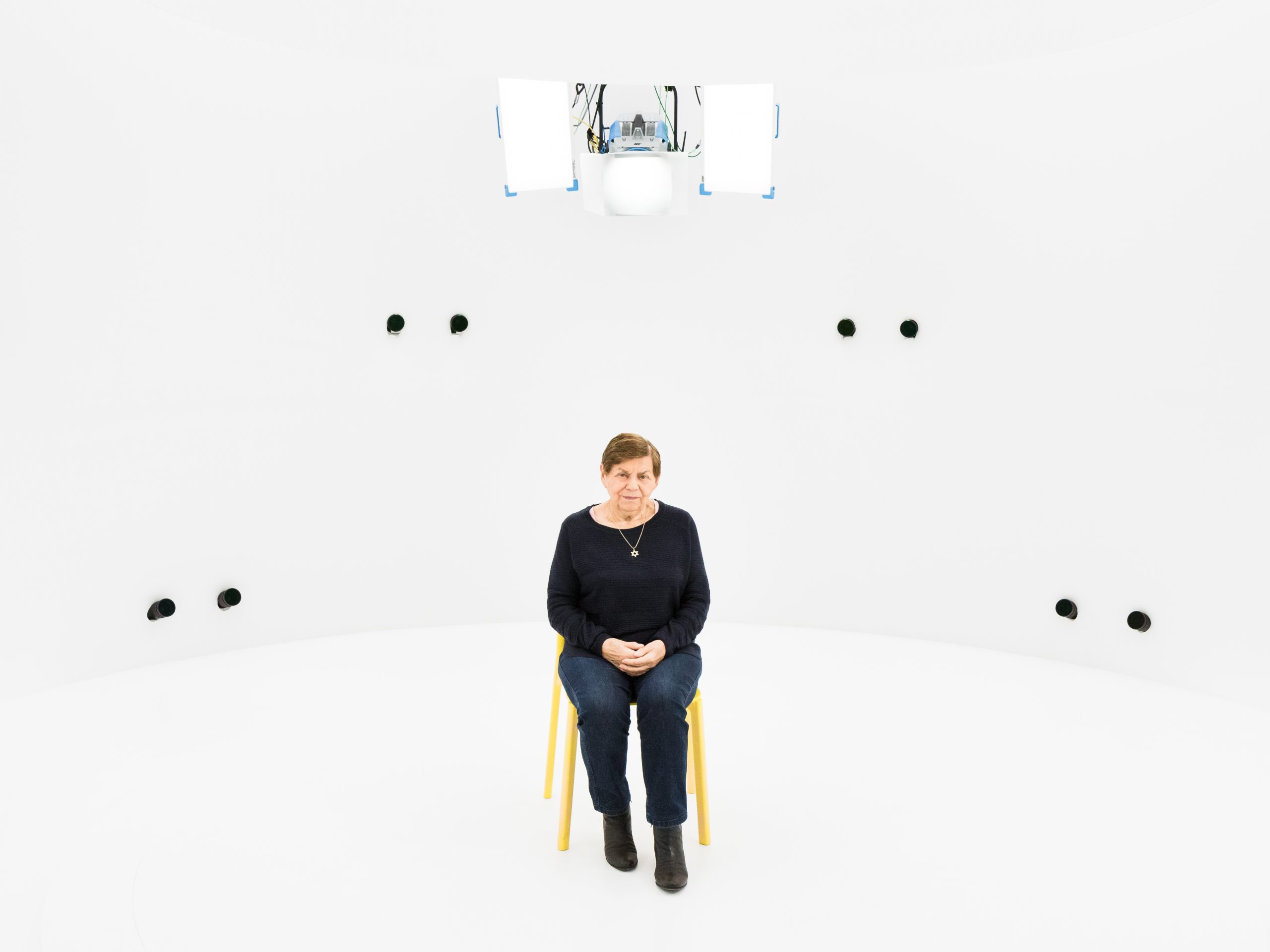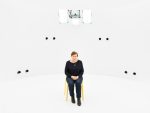The VR Project “For Real? – Virtual Encounters with Historical Eyewitnesses”
When Holocaust survivors talk about their experiences, they often do this at events, at the invitation of schools or in front of TV cameras. But now that more than 78 years have passed since the end of the Nazi regime, there are fewer and fewer eyewitnesses who can tell us about the horrors first-hand. It’s not only historians who are faced with the question of how can we communicate to the younger generations what happened back then and must not be allowed to be repeated? Immersive media such as Virtual or Augmented Reality applications offer a chance to approach the culture of memory in a new way. A special project that can be viewed from the end of August at various locations throughout Brandenburg is “For Real? - Virtual Encounters with Historical Eyewitnesses” which has been made possible thanks to a cooperation between the Brandenburg Society for Culture and History (BGK) and the Film University Babelsberg KONRAD WOLF, with funding from the Foundation Remembrance, Responsibility and Future (EVZ).Volucap was tasked with overseeing the technical processing, rendering and data management. The volumetric raw data of the interviews had already been recorded during a previous project.
„For Real…?“ is a nationwide pilot project that will hopefully offer points of departure on an international level as well since the problem of nascent anti-Semitism, racism and xenophobia is not one specific to Brandenburg (or Germany). The ability to hear and see authentic historical eyewitnesses recounting their traumatic experiences first-hand is a very important way of gaining a personal experience of historical events. “However, it will become even more important for us to preserve the “immediacy” of their stories once these witnesses are no longer with us,” Dr. Katalin Krasznahorkai, Lead Curator/Artistic Director at the Brandenburg Society for Culture and History, explains.
Volumetric eyewitness interviews
Holocaust survivors such as Inge Auerbacher, Leon Weintraub, Ruth Winkelmann, Kurt Hillmann and Charlotte Knobloch, all in their 80s and 90s, travelled to Babelsberg in 2021 to be interviewed. It was a completely new experience for them as well: being put in Volucap’s volumetric studio of a white dome with numerous cameras. They were interviewed by the documentary film director Christian Zipfel who supervised the project in an artistic and conceptual capacity on behalf of the Film University. He had only a limited recording time of about one hour to present the key aspects of their life stories. Unlike TV documentaries where the interviewees speak for several hours and an interview is edited from the footage, the testimonies here had to concentrate on the essentials.
This was due to the enormous amount of data that the volumetric recordings require. In an interview, Sven Bliedung von der Heide, CEO of Volucap, explains that “the resolution of our studio is a world leader, we can capture with 3,000 megapixels. That’s an immense amount of data. Storing and processing about five minutes of material is comparable to the amount of data for all the books existing in the world. This data doesn’t just want to be stored, it also wants to be processed.” This was also a challenge for the Volucap team who have used their volumetric capture equipment predominantly to provide sequences lasting a few minutes for films, video clips or games.
New approach to cultures of memory
The aesthetic adopted for the narrative here is also a different one. The white space of the studio was retained in the later VR application. “It was important for us that the recording situation remains transparent from a documentary perspective,” says Professor Björn Stockleben who was the project manager for “For Real?” on behalf of the Film University. “The previous project had seen us working with elaborate digital reconstructions of locations in Theresienstadt to provide a visual context for the testimony from the contemporary witness Margot Friedländer. We are focusing here on the immediate presence of the person who is speaking and thus only concentrating on the volumetric captures.”
The Film University team also developed the corresponding VR application. In order to do justice to the content of the interviews and, at the same time, be able to make important excerpts available, they organised a workshop where 9th grade pupils from Potsdam’s Voltaireschule rated the interview transcripts and selected the sections that they considered to be the most emotional, exciting and important. Young people are one of the most important target groups for the project. “It was fascinating to see how media savvy the pupils were and how they gave thought to ways of dealing with the technical possibilities and the subject’s complexity,” Dr Katalin Krasznahorkai notes.
They are used to a different kind of media consumption thanks to video games and the omnipresence of smartphones. “We know the witnesses from previous appearances on two-dimensional television. A representation that seems old-fashioned in this day and age. There is much more interaction possible with VR glasses. You then have the feeling that the person is standing in front of you,” Bliedung von der Heide from Volucap adds. However, it was important for all involved that the technology did not distract from the Holocaust survivors’ testimonies. “Communicating the subject matter is the most important thing - rather than wanting to have as immersive a media experience as possible,” director Christian Zipfel confirms.
The exhibition „For Real?“
The interviews will be shown in the exhibition “In Real?” from the end of August at various locations in Brandenburg - from Potsdam through Wittstock/Dosse, Kyritz, Pritzwalk, and Jüterbog to Cottbus and Finsterwalde. The Brandenburg Society for Culture has worked together with an agency to create an accompanying exhibition offering a lot of additional information. It is particularly important for them to make this format and virtual encounters with historical eyewitnesses of the Nazi terror accessible for regional and rural locations outside of the big cities as this is urgently needed there.
In the exhibition, the visitors use VR glasses to enter the digital space where ten questions will be floating in front of them. They can then follow topics in chronological order beginning with the November pogroms and continuing through to contemporary right-wing tendencies, including the AFD. Individual questions can be selected by eye-tracking control. In a next step, the interface disappears and one is confronted by a lifelike scan of one of the five Holocaust witnesses who gives a pre-recorded subjective answer. In the application, the exhibition visitor meets the witnesses on several occasions in response to different questions - this is also important as a way of establishing a certain bond with the protagonists and thus not consuming an unmanageable number of interview parts, according to director Zipfel.
An extensive archive of historical eyewitness accounts has thus been created alongside the current exhibition which will be launched on 29 August in the House of Brandenburg-Prussian History in Potsdam. “How will schoolchildren, students, multipliers or just passing visitors react to this opportunity to engage with historical witnesses and their stories by using VR glasses?” is one of the questions we will be posing as we accompany the project over the coming months, Dr Katalin Krasznahorkai says. The Film University will be overseeing the project’s scientific evaluation on behalf of the BGK and examining how the culture of memory is changing in the way it is communicated and how the experiences of contemporary witnesses can be kept alive for later generations.
Image Credit: Eyewitness in Volucap © Film University Babelsberg KONRAD WOLF, Photograph: Jakob Grasböck
About MTH Blog
The media technologies of the future are already being used today – not only in the entertainment sector, but also in a wide variety of industries. Christine Lentz meets up with tech enthusiasts, established companies and researchers for our monthly MediaTech Hub Potsdam blog to tell the stories behind the innovative business models.



